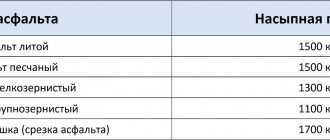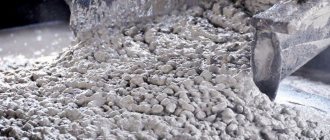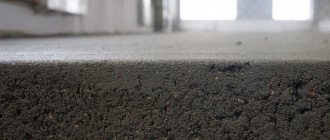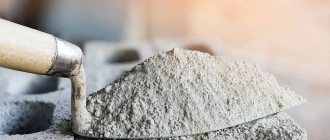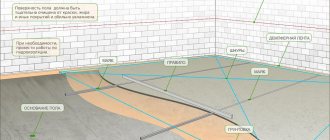When test purchasing materials, it is very important to pay attention to this indicator. Although, unfortunately, checking the density of a substance is not easy. But there is an average that suppliers must adhere to - 1300 kg/m³.
While mixing the solution, it is possible to compact it. To do this, you need to fill the container with coarse sand (a compacting agent), then add medium sand, and finally finer sand.
Calculation of the volumetric weight of cement for construction work
When working with building mixtures, incorrect calculations of the need for materials can affect the productivity and quality of the result. The specific gravity of cement, like any other bulk building material, is defined as: M/V, where M is mass and V is volume.
The resulting ratio of mass and volume is measured in - kg/m³. A clear example of calculations of hydrocarbons of well-known brands is in the table above.
As can be seen from the table, the specific gravity of cement m 500 , m 400 and m 300 is equal to or exceeds 1100 kg/m³. In production, there is a system for controlling the volumetric mass of a substance. It helps to establish the desired value using various types of additives (barium).
Concrete M150: main characteristics and composition
An indispensable building material, heavy concrete is in demand in all areas of construction. Concrete M150 is the most common brand of building material, covering almost all the needs of private developers in concrete for construction: foundations, walls, partitions and other building structures.
Accordingly, heavy concrete M150 is the best option for the construction of a private or country house, including the construction of outbuildings: garages, bathhouses, sheds and premises for keeping pets.
What is the density (specific gravity, volumetric weight) of cement-sand screed kg m3
Many technologies and materials are used to install floors and floor coverings, the choice of which depends on the purpose and operating conditions of the room or facility. The universal materials for performing this type of work are cement-sand mortars and concrete.
When choosing, you should take into account the various characteristics of the material for leveling, one of which is the density of the cement-sand screed in kg/m3. This indicator determines the total weight of the screed and the load on the base of the foundation or interfloor ceilings, exceeding which can lead to a decrease in the overall reliability of the building.
How much does 1 cube of cement weigh?
Question. Hello! Before buying cement for building a house, I want to learn how to handle the amount of cement in kilograms that fits into a container with a volume of 1 m3. How much does 1 cube of cement weigh? It is advisable to provide information on different types of binders. Thank you!
Answer. Good afternoon To fully understand the calculation of the amount of cement in kilograms that a 1 m3 container can hold, you should consider a variable characteristic - bulk or specific density, measured in kg/m3. Bulk density depends on the type of cement and the degree of its “freshness”. For example, the density of one of the most popular types, Portland cement, can have the following values:
- Freshly ground cement: 1100-1200 kg/m3.
- C cement lying (stored for a certain time): 1500-1600 kg/m3.
- Average payment value used for practical calculations: 1300 kg/m3.
Thus, theoretically, 1 m3 can fit from 1100 to 1600 kilograms of Portland cement. The exact figure should be determined in each specific case, for a specific batch. In the laboratories of concrete and cement plants, special equipment is used to determine the density of cement - the Le Chatelier device. At home, you can calculate the bulk density and determine how much 1 m3 of cement you purchased weighs as follows:
- Prepare any suitable 1-liter container and more or less accurate scales.
- Weigh the container and write down the numerical value of the mass in kg: M1.
- Pour cement into it. Do not compact or shake the container. Weigh again and write down the numerical value of the mass of the container with cement in kg: M2.
- Calculate the specific gravity using the following formula: (M2-M1)/0.001, where 0.001 is the volume of your vessel in m3. As follows from the above, the value of the resulting specific density is the answer to the question: How much does 1 cubic meter of cement weigh?
Due to the fact that different types of cements have different bulk densities, it makes sense to provide a comparative table of the specific densities of different types of binders:
| Type of cement | Specific density, kg/m3 |
| Portland cement | 1200-1300 |
| Slag Portland cement | 1100-1250 |
| Sulfate-slag | 1000-1200 |
| Pozzolanic Portland cement | 850-1150 |
| Sulfate resistant pozzolanic | 800-1100 |
| Aluminous | 950-1150 |
It is worth noting that the specific density of cement varies depending on its brand. For example, the theoretical density of the binder of the most popular brands: TsEM I 22.5N PTs, TsEM I 32.5N PTs and TsEM I 42.5N PTs (old markings M300, M400 and M500) is 1100 kg/3, and the density of cement M100, M150 and M200 is 900 kg/m3.
SNiP cement-sand screed
Cement-sand mortars for leveling floors are widely used in industrial, civil and individual construction. In the latter case, work is not always carried out according to project documentation, and the owners often take responsibility for choosing materials and leveling the base, relying on personal experience, advice from friends or information from the Internet. One of the options for protecting against possible errors in the absence of a project is to refer to publicly available construction industry standards.
Requirements for the design of floors in buildings for various purposes are regulated by the document SP 29.13330.2011 “Code of Rules. Floors”, in which, taking into account the emergence of new building materials and technologies, the introduction of additional safety requirements, the rules applied since 1988 SNiP 2.03.13-88 “Floors” have been updated. Sections of the set of rules determine the general requirements for the structural design of floors, as well as for the constituent elements: coating, interlayer, hydro- and vapor barrier, screed, underlying layer, foundation soil.
As the main criteria for making technical decisions, SP 29.13330.2011 determines the nature and intensity of mechanical effects on the floor, the intensity of exposure to liquids or aggressive environments, temperature conditions of operation, and ensuring sanitary and hygienic requirements. For industrial premises, special requirements are also taken into account, taking into account the specifics of the facility - the possibility of dust formation, the accumulation of static charges or sparking, the ability to clean and clean.
The information provided in the text of the document and in the appendix tables may also be useful for individual developers when choosing the type of floor and its covering, materials and performance of work, including the installation of a leveling screed.
Screed density and specific gravity of cement and sand
To construct a cement-sand screed (CSS), depending on the criteria specified by the operating conditions, various types of material can be used, differing in composition, density and strength:
- concrete with heavy filler;
- concrete with light filler;
- cement-sand mortar;
- dry mixes.
With heavy filler - granite screenings
The filler based on granite crushed stone screenings is the final product of the production of commercial crushed stone with a fraction of up to 10 mm. Concrete screed with granite filler is highly durable, frost-resistant and is used in industrial construction. In civil and residential construction it is used for premises with high operational loads - for basements and ground floors, garages, utility and storage spaces.
The density of concrete prepared using granite screenings is 1400-2200 kg/m³, which classifies it as heavy. The volumetric weight of a 5 cm thick screed for the specified density range ranges from 70 to 110 kilograms per 1 m2, which is a significant additional load on interfloor ceilings, floors with a soil or wooden base.
Light types of solutions - perlite, polystyrene, granules
In many cases, using a light screed will be more effective. It is used in cases where a large difference in heights is eliminated by leveling, when laying pipelines and communications in the floor, and also when it is necessary to obtain additional heat and sound insulating properties of the floor using a screed.
The density of light screed mortars ranges from 500 to 1800 kg/m³, depending on the type of filler and filler, and their proportions in the mixture. In terms of strength, light screed is inferior to mixtures with heavy filler, so sometimes it is used as an intermediate layer with final leveling with stronger solutions.
Several materials are used as fillers for light screeds, the addition of which to the mixture allows one to obtain various technical characteristics:
- Perlite is a porous rock that has good heat and sound insulation, high absorbency, fire resistance, and chemical inertness. For the preparation of building concrete and mortars, expanded perlite obtained by heat treatment of raw materials with a density of about 100 kg/m³ is used; the density of the mixture, depending on the composition of other components, ranges from 400 to 1000 kg/m³.
- Vermiculite is a natural mineral with a layered structure; expanded rock is used in construction. As a filler for mortars and concrete, it has properties and characteristics similar to perlite.
- Expanded clay with a volumetric weight of 150 to 800 kg/m³, obtained by firing clay or shale. Its characteristics are high strength, frost resistance, chemical resistance, non-flammability, and environmental friendliness. Expanded clay crushed stone with a fraction of up to 10 mm is used as a filler or serves as a raw material for the preparation of expanded clay sand.
- Granulated polystyrene foam (from polymer raw materials). The density of CPS based on it ranges from 150 to 600 kg/m³; they have a high degree of sound and heat absorption, frost resistance, but low strength compared to other lightweight solutions.
Peculiarities
Dry universal mixture M150 is intended for masonry, installation and finishing work. One of its main properties is the creation of an even plastic layer, which is necessary during construction, installation, bricklaying, and plastering. It is usually produced in bags of 50 kg, less often 40 or 25 kg. To prepare it, you just need to dilute it with the required amount of water indicated on the package and stir with a mixer.
Due to the presence of plasticizers and other components in their effective ratio, the dry universal mixture M150 has the following advantages:
- reliability and excellent quality;
- possibility of adhesion to many surfaces;
- frost resistance;
- economical consumption of material;
- good vapor permeability;
- protection from moisture.
The name “universal” speaks for itself. This means that this mixture can be used for many different jobs indoors and outdoors. It can be suitable for both moderate climates and severe northern frosts. Most often it is used for installation and laying of bricks and blocks, leveling surfaces, and concreting.
There are several varieties of the universal mixture M150, differing in composition and purpose.
- The plaster variety is intended for applying plaster manually or by machine; the layer thickness can be from 5 to 50 mm. It is suitable for facade and interior work. After mixing, the composition retains its beneficial properties for 120 minutes, so it is necessary to immediately begin applying plaster or not to mix large volumes. The applied composition acquires full strength after 28 days.
- masonry mixture is used for laying clay, silicate, refractory bricks, and gas silicate blocks. It has high frost resistance, so you can work with it outside in any weather conditions. The composition can also be used in rooms with high humidity.
- M150 screed mixture is used to level floors in various rooms. The layer can be from 1 to 10 cm; it is best to use a solution with beacons. With a layer thickness of 1 cm, the consumption of the dry mixture is 22-25 kg per 1 square meter. m. The advantages of M150 mortar for screed are that, thanks to the concrete base, it is durable, resistant to moisture and temperature changes.
Minimum and maximum screed thickness
SP 29.13330.2011 gives clear instructions on the minimum thickness of the screed layer to ensure the required floor slope: when laying on floor slabs, at least 20 mm, when laying on a waterproofing layer, on a heat and sound insulating layer - at least 40 mm. When covering pipelines (including in a heated floor system), the thickness of the screed must be at least 45 mm greater than the diameter of the pipelines. A smaller layer thickness can lead to cracking and destruction of the screed.
The minimum thickness of the screed layer recommended by experts is 30 mm. The optimal value of the screed is 40-50 mm; an increase in thickness entails excessive consumption of material, is limited by the permissible load-bearing capacity of the base even if light screeds are used, and requires additional reinforcement of the layer with reinforcement.
Sand-cement mixture: weight and density of the solution at consumption per 1 m2
Each construction of a structure must begin with the calculation of the amount of materials required for this action. Accordingly, various questions arise regarding the quantity, quality and standard proportions for the mixture. Knowing the volume of materials, it is possible to significantly save on purchasing only the necessary components. You also won’t have to travel for additional amounts of mixture, only if unplanned work arises. How to calculate the consumption of cement-sand mixture?
A mixture of cement and sand - characteristics and preparation of mortar
As a result of mixing cement and sand, a sand-cement mixture is obtained, which, when water is added, becomes suitable for use. On a large scale of construction independent preparation of the mixture is often used , although there is also a DSP specially prepared at the enterprise.
If you purchase a factory-made DSP , then in its composition, in addition to the basic components, there are plasticizers and other additives. They are used to give the solution homogeneity and plasticity; some add frost-resistant additives for work in the cold season.
Preparation of cement-sand mortar
The preparation of cement mortar greatly depends on the brand of cement and the required mortar. From this the required ratio of ingredients is calculated.
The number of components strongly depends on the purpose of the mixture, so some types of work involve a smaller amount of sand (concreting) or, conversely, a larger amount (masonry).
For more flexible preparation of the solution, sand and cement should be mixed manually; the standard ratio is 1 to 3, but it can be 1 to 2-4. The mixtures are also different; a huge range covers most ordinary needs.
To avoid unnecessary costs for materials that are not useful in construction, you should make a calculation. It will help you more accurately determine the required amount of mixture.
But it is not always possible to achieve an exact value due to the lack of information about the density of the material, because it may differ.
The purpose of cement plays an important role when choosing a brand:
- m100 is used only for plastering walls, approximate consumption 550-570 kg/m3;
- m150 is usually used for bricklaying, cinder block or installation; in rare cases, for concreting, the consumption is 570-590 kg/m3;
- m200 masonry and installation mixture must be prepared 590-620 kg/m3;
- m300 is used for concreting and pouring areas that bear increased load, consumption 620-660 kg/m3;
- m400 for especially strong concrete structures, consumption ranges from 660-710 kg/m3.
When calculating the required materials per 1 m3, it is possible to quite accurately determine the brand and quantity of PCB . They are also interchangeable, if the use of M150 is recommended, the cement can be replaced with M200 and M100 without much damage to the calculations and strength of the structure.
How much does 1 cube of cement weigh?
In modern construction conditions, not a single process can be completed without the use of concrete mixtures. Experienced specialists recommend mixing it yourself: this is the only way to obtain a high-quality mixture that meets regulatory and technical requirements. As part of the construction process, the use of a concrete mixture that is optimal in its physical and technical characteristics gives the corresponding result - a reliable and durable structure or structure.
However, when carrying out private work, the problem of determining the optimal proportional combination of mixture components often arises. Almost all formulas are based on volumetric measurements, while cement powders of various brands are sold in bags of 25-50 kg.
Important! To perform the calculation and convert the mass indicator into volume, you need to find out how many kilograms of cement 1 cubic meter contains, based on values such as specific gravity, volumetric weight, and also taking into account the true density of cement.
Determination of the amount of cement in kilograms per 1 m 3 of powder
| Brand name of cement powder | Weight of cement per 1m3 of concrete mixture of certain brands | |||
| M300 | M200 | M150 | M100 | |
| M500 | 510 | 410 | 330 | 250 |
| M400 | 600 | 490 | 400 | 300 |
| M300 | — | — | 510 | 390 |
If the cooking process is carried out according to the proportions of the combined components, then you need to know the calculation diagram. There are a number of nuances when determining how many kg of cement per 1 m 3 of powder is in bulk form.
The difference between such concepts as bulk density and specific density should be clearly understood. In the first case, the value depends on the “freshness” of the powder. For example, popular Portland cement has the following indicators for this parameter (kg/m3):
- freshly ground PC - 1100-1200;
- compacted (compacted as a result of storage) - 1500-1600;
- the average used for practical calculations is 1300.
Accordingly, the weight of 1 m 3 of cement can range from 1100 to 1600 kg. For greater accuracy, it is worth spending time on individual calculation of this value at home.
- Take a liter container and a scale.
- Weigh the container you use.
- Fill it with powder without compacting or shaking.
- Calculate the required value using the formula. To do this, from the mass of cement poured into the container (M2), subtract the figure (number) corresponding to the mass value of the container (M1) and divide by 0.001.
The value obtained in this way is the same mass of 1 m 3 of cement.
Purchasing quality cement powder
Contact the group to purchase quality material. Each characteristic of the powder provided will correspond to the declared values. Leave a request or call directly to order the required amount of building materials. Transportation is carried out throughout the entire Central Federal District.
Ask any question you are interested in to the competent managers of AlfaCem. They will help you choose the optimal type of binder, so that the customer can subsequently prepare a high-quality solution for any work, and will also tell you how much cement is in 1 m3 (kg). With us, you can be sure that the weight of a cubic meter of powder building material corresponds to the values that are necessary to solve the technical problems assigned to you. We wish you success!
How many materials will be needed - consumption per 1 m2, 1 m3
The amount of cement-sand mixture is calculated based on the cubic capacity of the room or site. You can easily calculate the footage using a regular tape measure, and then multiply the length by the width to get the area of the space that needs to be filled with cement.
The key parameter is the layer depth. Depth is a necessary indicator, as it directly affects consumption. On average, if the layer thickness is 10 mm, then 22 kg per m2 is required. For a 10 cm screed, 50 kg of M400 mixture is required.
To individually calculate the amount of mixture, you need to use the indicator 1 m3, this way you can calculate the volume of the solution. Here are some approximate calculations using a calculator to determine the amount of materials in construction.
If the area of the room is 100 m2, and the depth of the layer is 10 cm (must be converted to m), then it will be: 100 * 0.1 = 10 m3.
Very roughly, but per 1 m3 on average there are 555 - 713 kg of mixture; more accurate data should be contained on the packaging. If you mixed it by hand, you need to approximately calculate the required weight. The rule is that the higher the grade of the solution, the greater its weight.
M400 cement is characterized by a maximum weight of 700 kg per m3. As the grade decreases, the weight also decreases. M100 weighs approximately 550-600 kg per 1 m3.
This pattern is true for both manual and starting mixtures. The amount of dry mixture does not reflect its volume as a solution; 1 liter contains about 1.4 kg of dry mixture. Thus, if it is necessary to fill 10 m3, then the further calculation will be (using the example of M300):
(10 m3 * 650 kg)*1.4 = 9100 kg
Thus, to fill 10 m3 you will need a mixture in the amount of 6500 liters or 9100 kg of dry mixture .
Tables for calculating the weight and volume of cement
Knowing how much a bag of cement weighs (25 and 50 kg), the values can be easily recalculated using the same simple M/V formula. The table shows the parameters of the mass and volume of 1 cubic meter of cement.
The following table calculates the weight of cement mortar when measured in 10 liter buckets. Based on these data, if necessary, you can calculate the weight of a liter of cement by dividing the value by 10.
The table below shows how much cement in bags will be used for 1 cubic meter of solution and what mass of the composition will be obtained. The data is based on the weight of a bag of cement of 50 kg.
Having learned to calculate specific gravity and volume, you can no longer be afraid of making mistakes in further calculations. You will know exactly how much a kilogram of cement should be in relation to other ingredients of the solution.



